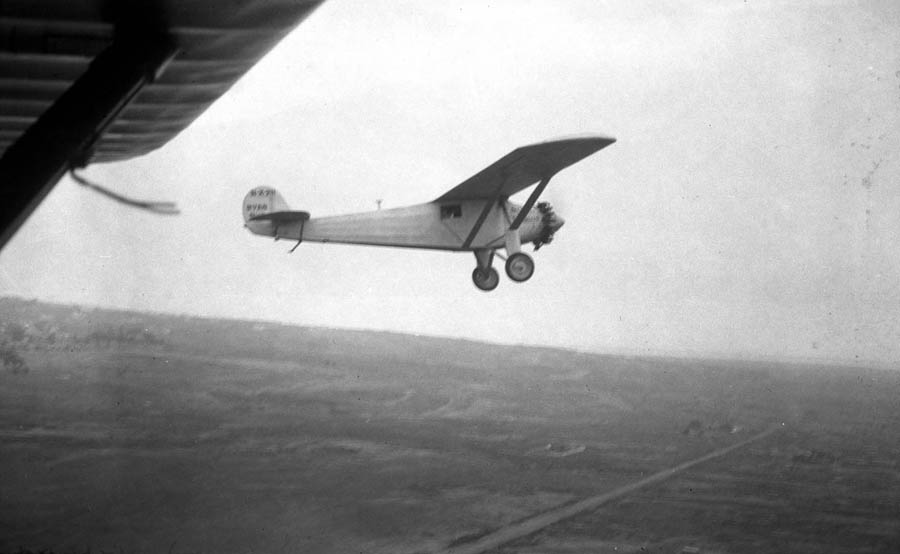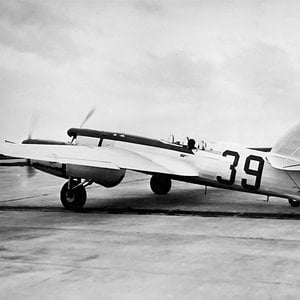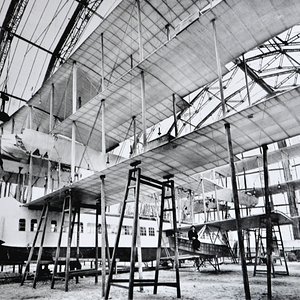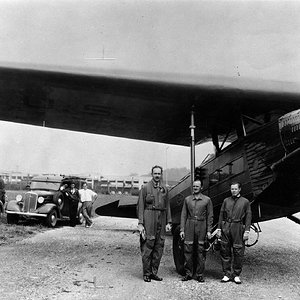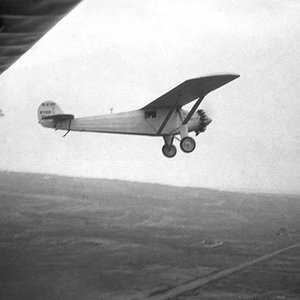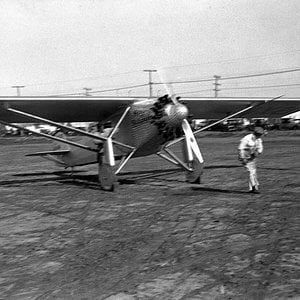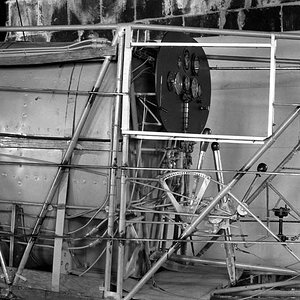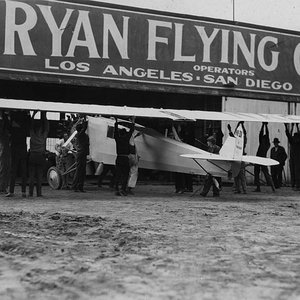Navigation
Install the app
How to install the app on iOS
Follow along with the video below to see how to install our site as a web app on your home screen.
Note: This feature may not be available in some browsers.
More options
You are using an out of date browser. It may not display this or other websites correctly.
You should upgrade or use an alternative browser.
You should upgrade or use an alternative browser.
Misty Friday morning, May 20, 1927
At 2:30 a.m. on a misty Friday morning, May 20, 1927, Lindbergh rode from the Garden City Hotel, where he and the other contestants were staying, to Curtiss Field to prepare for take-off. Even at that early hour, 500 on-lookers waited. At 4:15 a.m. the rain stopped. Lindbergh ate one of the six sandwiches he had been given the night before and ordered the Spirit of St. Louis to be wheeled outside. The weather had been too bad the night before to move the plane to Roosevelt Field. Six Nassau County motorcycle patrolmen escorted the concealed plane, which was tied to the back of a truck, and was hauled across the deeply rutted road to Roosevelt Field, where Lindbergh had planned to make his departure.
Take-off for Paris
With the nose of the plane pointing toward Paris, Lindbergh worried about the take-off. He would have 5,000 feet to lift off the ground and gain enough altitude to clear the trees and telephone wires at the end of the field. The Spirit of St. Louis had never been tested carrying 425 gallons, let alone the 25 gallons of extra fuel Lindbergh ordered added (the capacity of the tanks as built came out oversize by 25 gallons). If it weren't for the water-soaked runway, the lack of headwinds, the heavy humidity that would lower the engine's r.p.m., and the untested weight of the plane, he would not have been as concerned. A bucket brigade formed to fill the plane's five fuel tanks, and by 7:30 a.m. the tanks were filled to the brim. Hundreds more people joined the crowd. With the wheels sinking into the muddy ground, Lindbergh readied himself for take-off, mentally going over his checklist and gathering all his flying experience from the past four years. Should he wait or go ahead? There were too many uncertainties, except his trust and experience in this custom designed plane.
Charles Lindbergh and the Spirit of St. Louis on the way to Paris!
View additional pictures from the Donald Hall Photograph Collection. All photographs are protected by federal copyright law.
At 7:51 a.m. he buckled his safety belt, put cotton in his ears, strapped on his helmet, and pulled on his goggles and said, "What do you say -- let's try it." At 7:52 a.m., Lindbergh took-off for Paris, carrying with him five sandwiches, water, and his charts and maps and a limited number of other items he deemed absolutely necessary. The heavy plane was first pushed, then rolling, and finally bounced along the muddy runway, splashing through puddles. At the halfway point on the runway, the plane had not yet reached flying speed. As the load shifted from the wheels to the wings, he felt the plane leave the ground briefly, but returned to the ground. Looking out the side window, Lindbergh could see the approaching telephone lines. Now less than 2,000 feet of runway remained and he managed to get the plane to jump off the ground, only to touch down again. Bouncing again, and with less than 1,000 feet, he lifted the plane sharply, clearing the telephone wires by 20 feet. At 7:54 a.m. he was airborne.
33 hours, 30 minutes, and 29.8 later at LeBourget Field, Paris
Although he had no forward vision during the flight (except a small periscope), and fighting off fog, icing, and overwhelming fatigue, he navigated his journey to a perfect landing 33 hours, 30 minutes, and 29.8 seconds later at LeBourget Field, Paris where a huge crowd of 150,000 on-lookers awaited his arrival. At that very moment when he was pulled out of his plane, the 25-year-old farm boy from Minnesota was transformed into the most famous hero the world had ever known.
At 2:30 a.m. on a misty Friday morning, May 20, 1927, Lindbergh rode from the Garden City Hotel, where he and the other contestants were staying, to Curtiss Field to prepare for take-off. Even at that early hour, 500 on-lookers waited. At 4:15 a.m. the rain stopped. Lindbergh ate one of the six sandwiches he had been given the night before and ordered the Spirit of St. Louis to be wheeled outside. The weather had been too bad the night before to move the plane to Roosevelt Field. Six Nassau County motorcycle patrolmen escorted the concealed plane, which was tied to the back of a truck, and was hauled across the deeply rutted road to Roosevelt Field, where Lindbergh had planned to make his departure.
Take-off for Paris
With the nose of the plane pointing toward Paris, Lindbergh worried about the take-off. He would have 5,000 feet to lift off the ground and gain enough altitude to clear the trees and telephone wires at the end of the field. The Spirit of St. Louis had never been tested carrying 425 gallons, let alone the 25 gallons of extra fuel Lindbergh ordered added (the capacity of the tanks as built came out oversize by 25 gallons). If it weren't for the water-soaked runway, the lack of headwinds, the heavy humidity that would lower the engine's r.p.m., and the untested weight of the plane, he would not have been as concerned. A bucket brigade formed to fill the plane's five fuel tanks, and by 7:30 a.m. the tanks were filled to the brim. Hundreds more people joined the crowd. With the wheels sinking into the muddy ground, Lindbergh readied himself for take-off, mentally going over his checklist and gathering all his flying experience from the past four years. Should he wait or go ahead? There were too many uncertainties, except his trust and experience in this custom designed plane.
Charles Lindbergh and the Spirit of St. Louis on the way to Paris!
View additional pictures from the Donald Hall Photograph Collection. All photographs are protected by federal copyright law.
At 7:51 a.m. he buckled his safety belt, put cotton in his ears, strapped on his helmet, and pulled on his goggles and said, "What do you say -- let's try it." At 7:52 a.m., Lindbergh took-off for Paris, carrying with him five sandwiches, water, and his charts and maps and a limited number of other items he deemed absolutely necessary. The heavy plane was first pushed, then rolling, and finally bounced along the muddy runway, splashing through puddles. At the halfway point on the runway, the plane had not yet reached flying speed. As the load shifted from the wheels to the wings, he felt the plane leave the ground briefly, but returned to the ground. Looking out the side window, Lindbergh could see the approaching telephone lines. Now less than 2,000 feet of runway remained and he managed to get the plane to jump off the ground, only to touch down again. Bouncing again, and with less than 1,000 feet, he lifted the plane sharply, clearing the telephone wires by 20 feet. At 7:54 a.m. he was airborne.
33 hours, 30 minutes, and 29.8 later at LeBourget Field, Paris
Although he had no forward vision during the flight (except a small periscope), and fighting off fog, icing, and overwhelming fatigue, he navigated his journey to a perfect landing 33 hours, 30 minutes, and 29.8 seconds later at LeBourget Field, Paris where a huge crowd of 150,000 on-lookers awaited his arrival. At that very moment when he was pulled out of his plane, the 25-year-old farm boy from Minnesota was transformed into the most famous hero the world had ever known.

